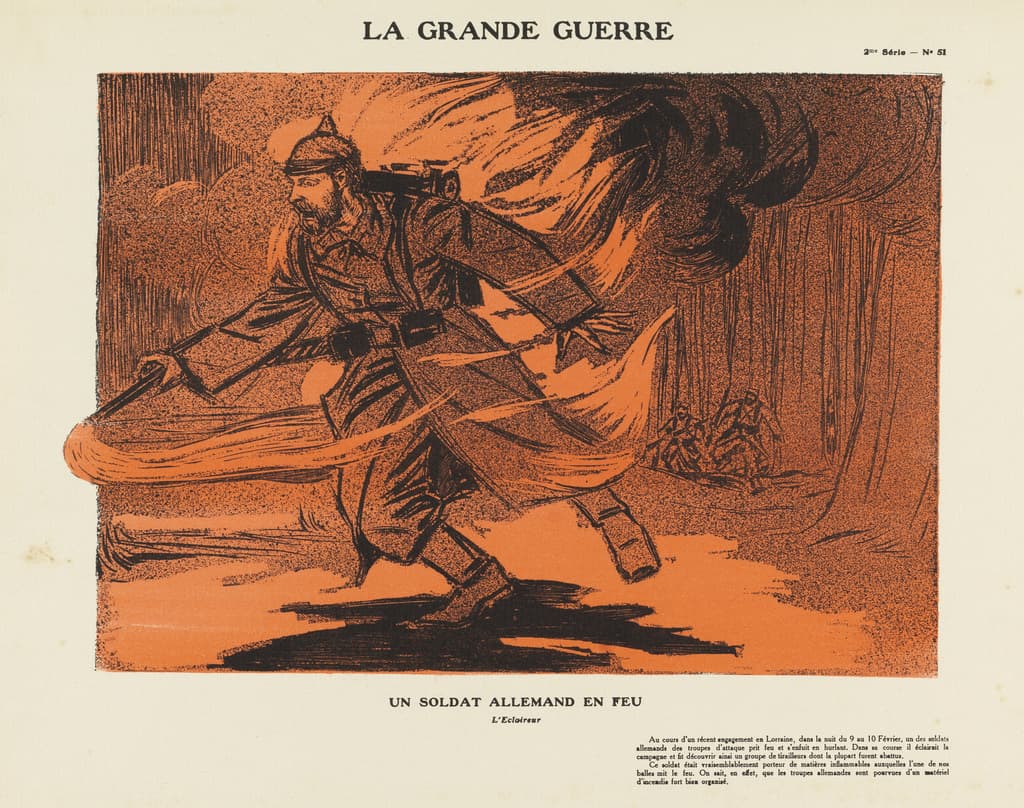
Unknown artist
Un soldat allemand en feu…
A German soldier on fire. The scout
Lithograph with hand colouring through stencils. Publisher: Tolmer & Co. 1915.
Given by Sophie Gurney 1994
No. 51 from the 2nd series La Grande Guerre .
A depiction of a reported event in Lorraine in early February 1915. The stylised nature of the series made it possible to portray this sort of terrible subject, as a drawing or photograph could not. Notice that the German soldier is not physically caricatured. In some of the prints’ captions there are hints at flaws in the German soldiers’ characters (e.g. abandoning the wounded, see nos. 17 , 21 and 25 ) but nowhere does the text resort to the racial epithets used in newspapers, such as Bosche , a slang word derived from an old French word for ‘head’ that had taken on connotations of obstinacy.
At no time before had so many soldiers seen such damage to their bodies. From the early battles French military services were overwhelmed by scores of men far more seriously wounded than they were prepared for. Medical staff were not able to cope with the sheer number and seriousness of wounds, most of which had been caused by shell explosions, shrapnel balls and new types of bullets. The French were the first to use gas in chemical warfare, although it was tear gas rather than chlorine, phosgene or mustard. The Germans were the first to develop flame-throwers, backpacks containing compressed nitrogen, and a mixture of coal tar and benzene, connected to hoses. ‘Liquid fire’ was used for the first time in trenches near Verdun in February 1915. French men who survived the war with wounded faces became known as gueules cassées (‘men with broken faces’), while those suffering with traumatic shock (attributed to the fear of exploding shells, hence the English term ‘shell-shock’) were referred to in French as victims of commotion (‘concussion’), choc émotionnel (‘emotional shock’) or obusite (shell-itis).
The French caption with English translation:
UN SOLDAT ALLEMAND EN FEU. L’Eclaireur
Au cours d’un récent engagement en Lorraine, dans la nuit de 9 au 10 Février, un des soldats allemands des troupes d’attaque prit feu et s’enfuit en hurlant. Dans sa course il éclairait la campagne et fit découvrir ainsi un groupe de tirailleurs dont la plupart furent abattus. Ce soldat était vraisemblablement porteur de matieres inflammables auxquelles l’une de nos balles mit le feu. On sait, en effet, que les troupes allemands sont pourvues d’un matériel d’incendie fort bien organisé.
A German soldier on fire
During a recent battle in Lorraine, on the night 9-10 February, one of the German soldiers of the attacking troops caught fire and fled, screaming. In his wake he lit up the countryside and uncovered a group of riflemen, most of whom were killed. This soldier was probably carrying flammable materials that one of our shells set on fire. Indeed, we know that the German troops are equipped with well-orgainsed fire equipment.




